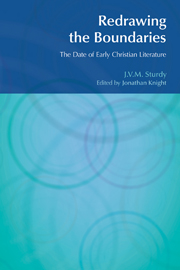Book contents
- Frontmatter
- Contents
- Preface
- Abbreviations
- 1 The Problem Posed
- 2 1 Clement
- 3 The Letters of Ignatius
- 4 Polycarp
- 5 Early Christian Literature: Some Parameters of Date
- 6 The Relationship of the Synoptic Gospels
- 7 Mark
- 8 Luke
- 9 Matthew
- 10 Acts
- 11 The Pauline Corpus: Its Growth and Development
- 12 The Catholic Epistles
- 13 Johannine Literature
- 14 Summary and Conclusions
- Appendix
- Notes
- Bibliography
- Index of Names
- Index of References
3 - The Letters of Ignatius
- Frontmatter
- Contents
- Preface
- Abbreviations
- 1 The Problem Posed
- 2 1 Clement
- 3 The Letters of Ignatius
- 4 Polycarp
- 5 Early Christian Literature: Some Parameters of Date
- 6 The Relationship of the Synoptic Gospels
- 7 Mark
- 8 Luke
- 9 Matthew
- 10 Acts
- 11 The Pauline Corpus: Its Growth and Development
- 12 The Catholic Epistles
- 13 Johannine Literature
- 14 Summary and Conclusions
- Appendix
- Notes
- Bibliography
- Index of Names
- Index of References
Summary
The major question to be considered concerning Ignatius is whether a date for him in the early second century can really be accepted. We have no firm knowledge of the date of his death. It is generally set around 107–10 CE (the date that Eusebius apparently holds). If there was no persecution under Domitian, it looks less easy to have a persecution of Ignatius as such, particularly when we consider that the literary Ignatius has persecution as part of his mindset. A date before 115 makes it impossible to refer it to Trajan's persecution; and even this is hard to do.
I take it as agreed, in dealing with the Ignatian correspondence, that the shorter (or middle) recension of seven letters is the more original and that this goes back to the second century; and that the Syrian (shortest) text is not a serious competitor for authenticity but simply a shortened form of text. The reason that one might want, from a New Testament point of view, to move Ignatius from 107 is not so much the fact that he quotes New Testament writers whom it is awkward to put before him, but that his understanding of church order is so much more advanced than that of 1 Clement that we would have to put 1 Clement back to 96 to explain this. This revives the problems that made us want to put 1 Clement later than this.
- Type
- Chapter
- Information
- Redrawing the BoundariesThe Date of Early Christian Literature, pp. 8 - 13Publisher: Acumen PublishingPrint publication year: 2008

